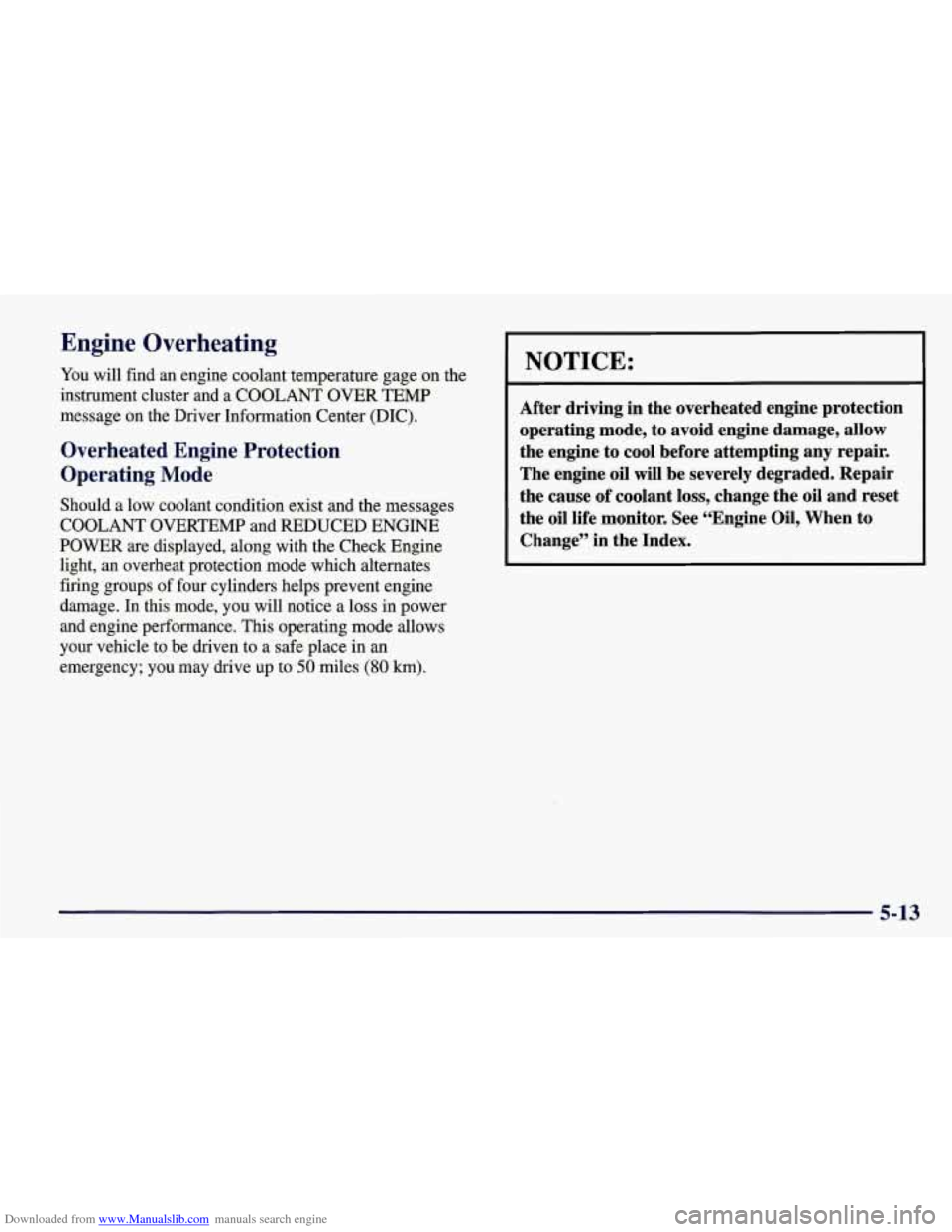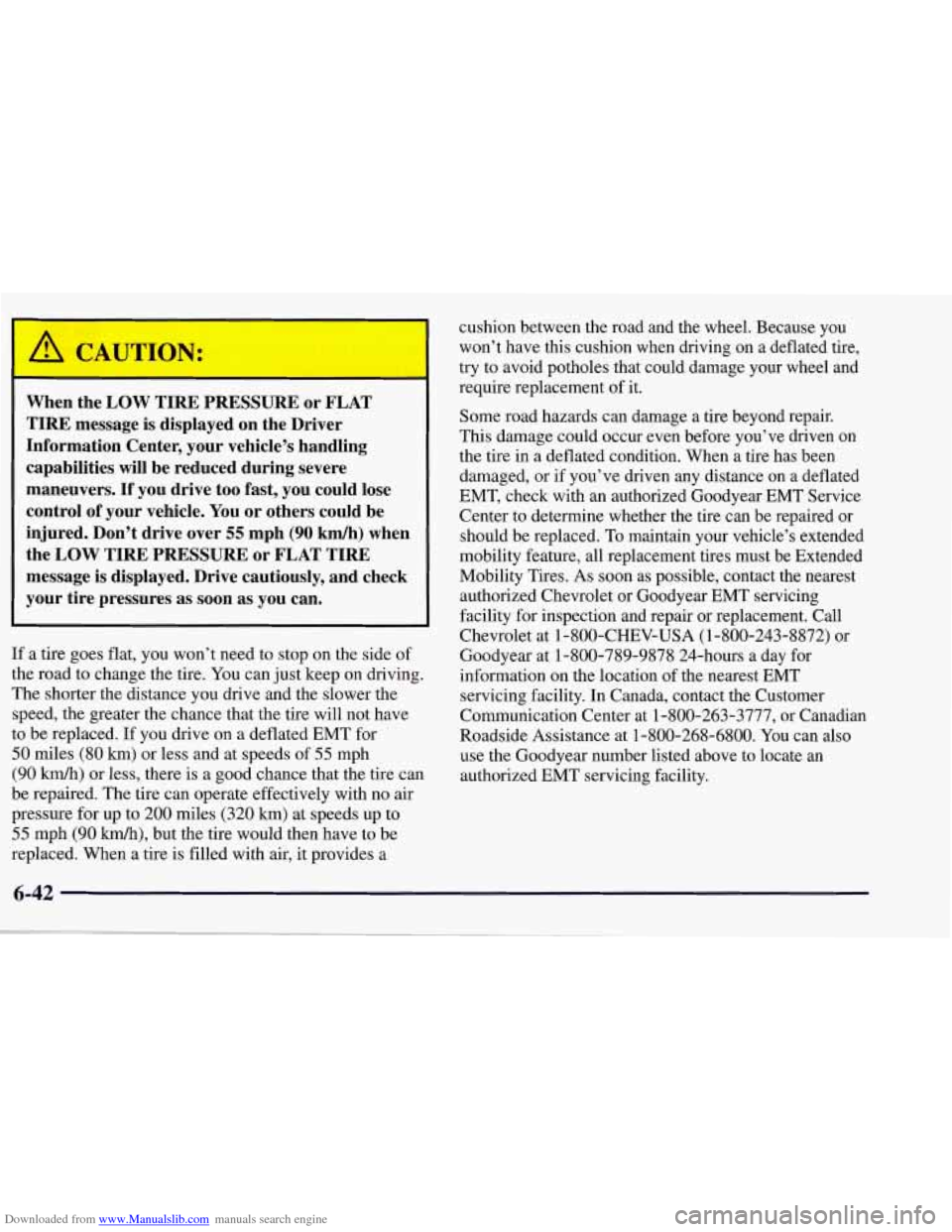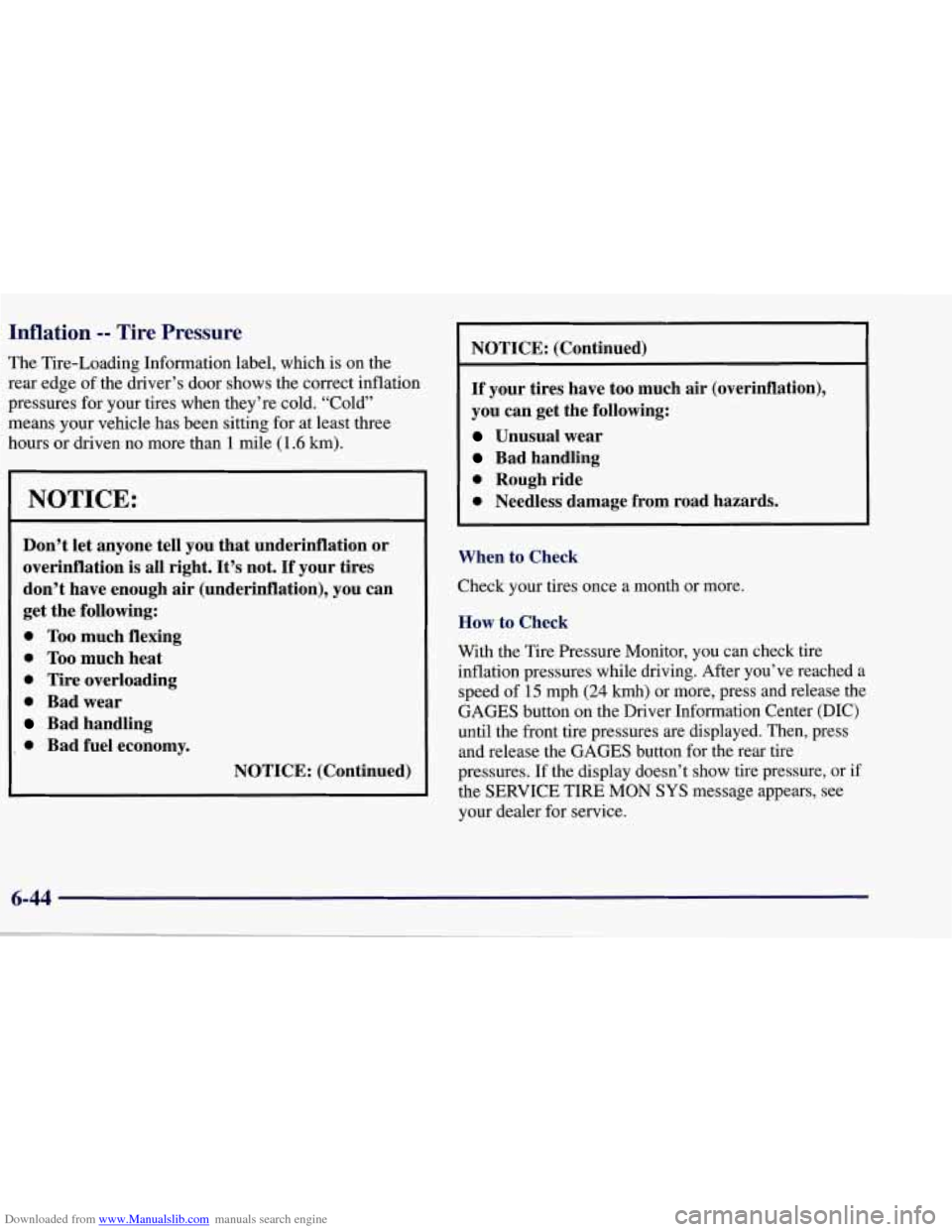1998 CHEVROLET CORVETTE display
[x] Cancel search: displayPage 234 of 378

Downloaded from www.Manualslib.com manuals search engine Engine Overheating
You will find an engine coolant temperature gage on the
instrument cluster and a COOLANT OVER TEMP
message on the Driver Information Center
(DIC).
Overheated Engine Protection
Operating Mode
Should a low coolant condition exist and the messages
COOLANT OVERTEMP and REDUCED ENGINE
POWER are displayed, along with the Check Engine
light, an overheat protection mode which alternates
firing groups of four cylinders helps prevent engine
damage. In this mode, you will notice a loss in power
and engine performance. This operating mode allows
your vehicle to be driven to a safe place in an
emergency; you may drive up
to 50 miles (80 km).
1 NOTICE:
After driving in the overheated engine protection
operating mode, to avoid engine damage, allow
the engine to cool before attempting any repair.
The engine oil will be severely degraded. Repair
the cause of coolant loss, change the oil and reset
the oil life monitor. See “Engine Oil, When to
Change” in the Index.
5-13
Page 287 of 378

Downloaded from www.Manualslib.com manuals search engine i ,h, CAUTION:
When the LOW TIRE PRESSURE or FLAT TIRE message is displayed on the Driver
Information Center, your vehicle’s handling
capabilities will be reduced during severe
maneuvers.
If you drive too fast, you could lose
control of your vehicle.
You or others could be
injured, Don’t drive over
55 mph (90 km/h) when
the
LOW TIRE PRESSURE or FLAT TIRE
message is displayed. Drive cautiously, and check
your tire pressures as soon as you can.
I
I
If a tire goes flat, you won’t need to stop on the side of
the road to change the tire. You can just keep on driving.
The shorter the distance you drive and the slower the
speed, the greater the chance that the tire will not have
to be replaced.
If you drive on a deflated EMT for
50 miles (80 km) or less and at speeds of 55 mph
(90 km/h) or less, there is a good chance that the tire can
be repaired. The tire can operate effectively with no air
pressure for up to 200 miles (320
km) at speeds up to
55 mph (90 km/h), but the tire would then have to be
replaced. When a tire is filled with air, it provides a cushion between the
road and the wheel. Because you
won’t have this cushion when driving on a deflated tire,
try to avoid potholes that could damage your wheel and
require replacement of it.
Some road hazards can damage a tire beyond repair.
This damage could occur even before you’ve driven on
the tire in
a deflated condition. When a tire has been
damaged, or
if you’ve driven any distance on a deflated
EMT, check with an authorized Goodyear EMT Service
Center to determine whether the tire can be repaired or
should be replaced. To maintain your vehicle’s extended
mobility feature, all replacement tires must be Extended
Mobility Tires. As soon as possible, contact the nearest
authorized Chevrolet or Goodyear EMT servicing
facility for inspection and repair or replacement. Call
Chevrolet at 1-800-CHEV-USA (1-800-243-8872) or
Goodyear at 1-800-789-9878 24-hours a day for
information on the location of the nearest EMT
servicing facility. In Canada, contact the Customer
Communication Center at 1-800-263-3777, or Canadian
Roadside Assistance at 1-800-268-6800. You can also
use the Goodyear number listed above to locate an
authorized EMT servicing facility.
Page 289 of 378

Downloaded from www.Manualslib.com manuals search engine Inflation -- Tire Pressure
The Tire-Loading Information label, which is on the
rear edge of the driver’s door shows the correct inflation
pressures for your tires when they’re cold. “Cold”
means your vehicle has been sitting for at least three
hours or driven no more than
1 mile (1.6 km).
NOTICE:
Don’t let anyone tell you that underinflation or
overinflation is all right. It’s not.
If your tires
don’t have enough
air (underinflation), you can
get the following:
0 Too much flexing
0 Too much heat
0 Tire overloading
0 Bad wear
Bad handling
0 Bad fuel economy.
NOTICE: (Continued) NOTICE: (Continued)
If your tires
have too much air (overinflation).
you can get the following:
Unusual wear
Bad handling
0 Rough ride
0 Needless damage from road hazards.
When to Check
Check your tires once a month or more.
How to Check
With the Tire Pressure Monitor, you can check tire
inflation pressures while driving. After you’ve reached a
speed
of 15 mph (24 kmh) or more, press and release the
GAGES button on the Driver Information Center (DIC)
until the front tire pressures are displayed. Then, press
and release the GAGES button for the rear tire
pressures.
If the display doesn’t show tire pressure, or if
the SERVICE TIRE
MON SYS message appears, see
your dealer for service.
Page 358 of 378

Downloaded from www.Manualslib.com manuals search engine Player ...................................... 3-17
Care
....................................... 3-29
Competitive Driving
............................ 2-24
Console. Center
........................... .. .... 2-55
Control of a Vehicle
.............................. 4-5
Convenience Net
............................... 2-57
Convenience Net. Cleaning
....................... 6-54
Convertible Top
................................ 2-68
Convex Outside Mirror
.......................... 2-54
Coolant
............................. 5.13.5.16. 6.22
SurgeTank
.................................. 5-18
Surge Tank Pressure Cap
....................... 6-26
Coolant Heater. Engine
.......................... 2-24
CoolingSystem
................................ 5-16
Courtesy Lamps
................................ 2-52
InCanada
.................................... 8-8
1ntheU.S. ................................... 8-8
Cruise Control ................................. 2-47
Customer Assistance for Text Telephone Users
......... 8-4
Customer Assistance Infomation
................... 8- 1
Customer Satisfaction Procedure .................... 8-2
Damage. Finish
............................... 6-59
Daytime Running Lamps
......................... 2-50
Dead Battery
................................... 5-3
Defects. Reporting Safety
........................ 8- 10
InCanada
................................... 8-11
To General Motors
............................ 8- 11
Defensive Driving
............................... 4-2
Defogger. Rear Window
......................... 3- 11
Defogging ............................ 3-3.3-7. 3-11
Defrosting ................................ 3-3. 3-11
Dimensions. Vehicle
............................ 6-7 1
Dolby B Noise Reduction ........................ 3-16 Door
Locks
....................................... 2-4
Downshifting
.................................. 2-31
Driver Information Center (DIC)
................... 2-87
Warnings and Messages
........................ 2-97
Controls and Displays
......................... 2-88
ABS active
.................................. 2-98
Charge System Fault
.......................... 2-99
Coolant Over Temp
.......................... 2- 101
Flat Tire
. (lf. lr. rf. rr) ........................ 2-104
High Oil Temperature Reduce Engine rpm
........ 2- 102
High Tire Pressure
. (If. lr. rf. rr) ................ 2-105
High Trans Temp
............................ 2- 102
Low Coolant
................................ 2- 101
LowOilLevel ............................... 2-99
Low
Oil Pressure ............................. 2-98
Low Tire Pressure
. (If. lr. rf. rr) ................ 2-103
Maximum Speed
80 mph (129 Wh) ............ 2-101
Reduced Engine Power
........................ 2-99
ServiceABS
................................. 2-98
Service Column Lock
.......................... 2-98
Service Ride Control
......................... 2- 101
Service Tire Monitor (MON) System (SYS) ....... 2-106
Service Traction System
...................... 2-100
Service Vehicle Soon
.......................... 2-99
Shocks Inoperative
........................... 2- 10 1
Traction System
- OFF ....................... 2-100
Traction System
- ON ........................ 2-100
Traction System
(SYS) Active .................. 2-100
Driver Position
................................. 1-11
Driving
........................................ 4-1
City
........................................ 4-19
Defensive
.................................... 4-2
Driver Information Center
(DIC) Messages
9-3